![]() 1st Battalion 22nd Infantry
1st Battalion 22nd Infantry ![]()
The Battle of the Rock
By James Henderson B/1-22, 2nd
Platoon
We, Bravo Co. 1/22 4th Infantry
Division, were combat assaulted, CA’d, into the valley floor
along the Dak Kron Bung River in Binh Dinh Province on 19 Jun
1970. For the remainder of the first day, along the river, we ran
search and clear operations, received resupply and set up night
ambushes. All three platoons stayed in the valley floor the rest
of the day and that night.
Everyone’s memories of the events of the next day, 20 Jun,
are different, as they should be and as one would expect.
Although we were all an integral part of a much larger overall
event that took place, each one of us, as individuals, had
different things happen to us and in some of those cases, vastly
different things. That’s why one man’s recollections
can sometimes vary widely from the next man’s and
that’s why we each have a story to tell. I recently read an
interview with a WW2 vet who was a combat medic on Omaha Beach on
D-Day. He was asked about his viewpoint on the carnage of that
day. He said something to the effect that, at the time, he knew
only what was happening directly in front of him and to a lesser
extent to his immediate left and right. He was so focused on his
own tiny space that he really could not comment on other
people’s experiences or opinions. My hope is that all those
who were there that day and who read these words will find truth
and to the best of my memory, some degree of accuracy. Whenever
possible, I relied on historical evidence such as the
handwritten, real time, S-3 Daily Logs, 2nd Bde S-2 Daily
Journal, 4th Inf Div G-2 Intelligence Summaries, 4th Div Bde HQ
Operational Report Lessons Learned (ORLL’s), 4th Div
Artillery ORLL’s, and Unit History and even newspaper
articles. I consulted each and every person that I could locate,
who was there that day, and I picked their brains. What follows
are my memories of that day, fully realizing that the men of 1st
Platoon and the men of 3rd Platoon who were in the valley floor
engaged in their own individual fights for survival will have
quite different experiences, memories and stories. The timeline,
the chronology, is taken exactly from the S-3 Daily Logs. I have
tried my very best not to exaggerate, embellish or boast about
events but to record them as the Logs and my memory and my
friend’s memories best recall them.
On the morning of the 20th of Jun, at 0840, elements of 3rd
platoon, operating on a high-speed trail along the river in the
valley floor, engaged a North Vietnamese Army (NVA) force of
approximately 5 to 6 men at grids BR592 813. One NVA was Killed
In Action (KIA) and the rest of them fled up the side of the
mountain, breaking brush through the jungle. Rather than break
brush to follow them, Captain (CPT) Gilbert Tijerina, our B
Company Commander, ordered 2nd platoon to take a trail running up
the ridgeline of the mountain in an effort to cut off the escape
of what was thought to be 4 or 5 individuals. We, 2nd Platoon,
had traveled this very trail up this mountain ridgeline some two
months previously, during the last 9 days of April. It was steep
and tough going but we pushed hard in order to cut off the
fleeing enemy. We had humped about an hour without rest, at a
frantic pace, and were nearing the top.
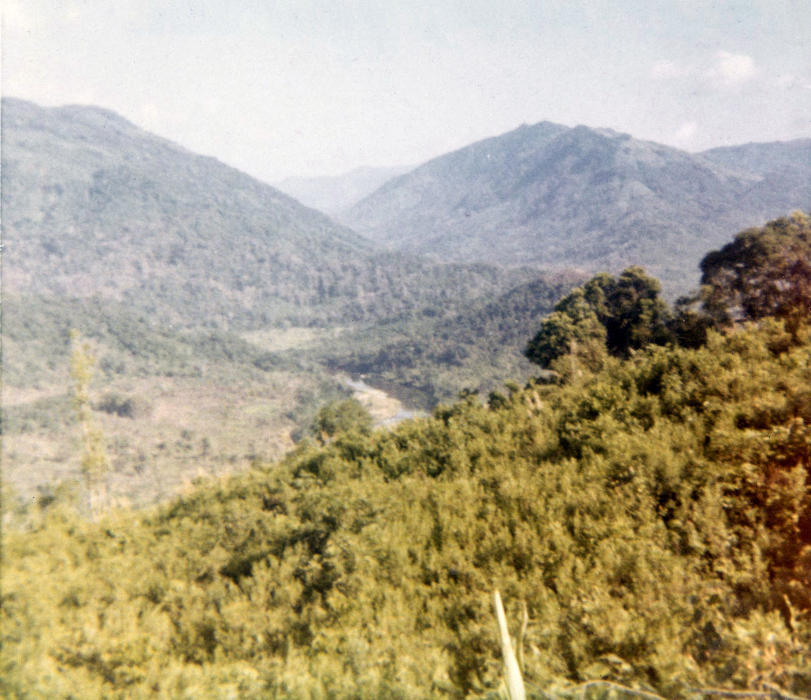
Nearing the top
Our ranks had been severely
depleted of our most experienced old timers in the past few days
and weeks, 2nd platoon itself had lost 12 men to a June Date of
Estimated Return from Over Seas (DEROS). Some had already left
for various reasons earlier but even so, we lost 7 experienced
men in June before the 20th. By the 20th they had all left the
field. There were 19 of us in the platoon that day. Of the 19
men, several were mortar men, 11C’s, not infantrymen,
11B’s. Some had tenured time in country but not actual
experience in the field.
On this day, to the best of our collective memories the following
men constituted
the 2nd Platoon Roster:
LT Dwight Warfield, SGT Richard Buenzle, RTO’s Rey Blazon
and Dave Brown, Lam our Vietnamese scout, an unknown medic and
unknown dog handler.
SGT Joseph “Cat” Akczinski, Al Brick, Donald Gary
Myself, James Henderson, Jeff Thurman, Gilbert Brown
Robert “Holly” Holloway, Jim Killian
Jimmie “Smoke” Carter, Joe Badger
Salvadore Ramos
For many years we believed the total to be 19 men, and always
stated it as such in conversation, beginning in the weeks
immediately following the battle. So, there are others who may,
or may not, have been there that day. These are the ones we know
for sure.
Many of these men have passed away in the intervening years and
we can’t track them down and ask them.
At approximately 0940 as our point squad, consisting of myself,
James Henderson, as newly appointed squad leader due to SGT
Richard Buenzle acting as Platoon SGT, point man PFC Jeff
Thurman, our platoon leader, First Lieutenant (1LT) Dwight
Warfield, a scout dog handler with his scout dog and a couple of
11C’s just recently recruited from the firebase mortar
platoon to fill our depleted ranks, reached the summit, at grids
BR601 819.
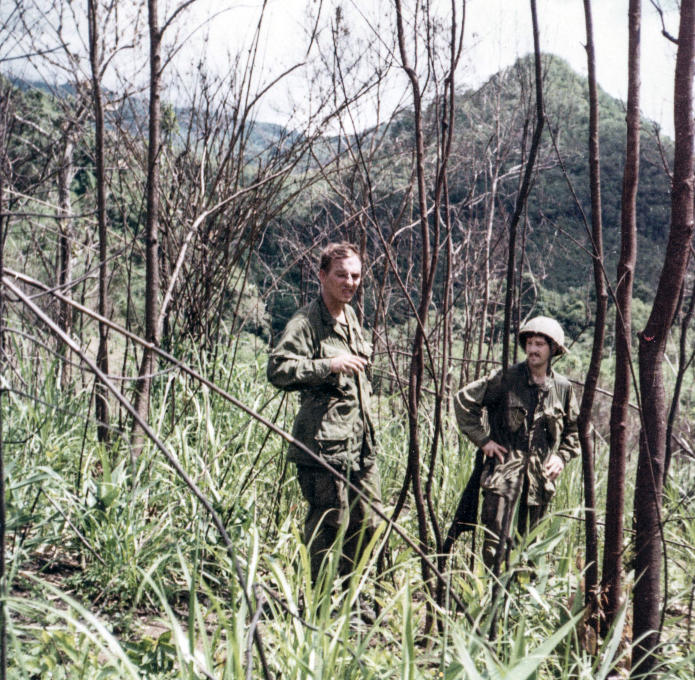
LT Dwight Warfield and SGT Richard Buenzle
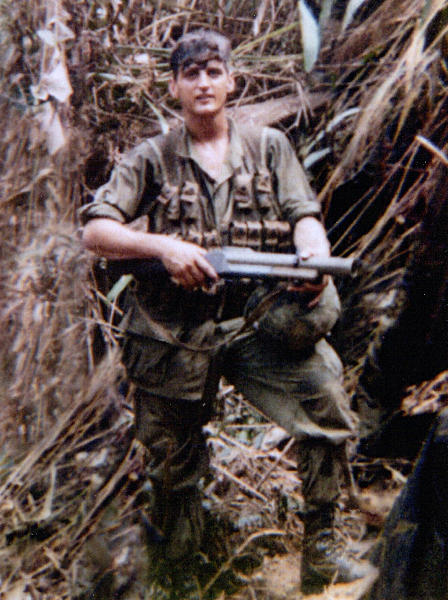
James Henderson
LT Warfield was an experienced
combat Platoon Leader who had done 6 months as a Platoon Leader
in the field and then taken over as our Company XO, Executive
Officer, supposedly to finish out his tour. But, due to a lack of
combat officers, he had been pressed back into service to lead a
platoon in the field. He was a good man and very competent
leader.
LT Warfield halted the column in place on the trail. As we
prepared to catch our breath, our Vietnamese scout, Lam, who was
next in line of march behind the dog handler points to our left,
the west, and says “look, GI asleep” and points a few
yards, perhaps 20-30 feet, through incredibly dense triple canopy
foliage. Next in line behind Lam is one of our M60 machine gun
team leaders, SP4 Robert “Holly” Holloway. Holly,
standing with his assistant gunner, PFC James Killian, peers
through the thick underbrush and can make out a pith helmet and
AK47 rifle. Holly is a bold and decisive gunner and he replies
“GI my ass, that’s a gook”. He doesn’t need
anyone to tell him to open fire, he hits the ground and opens up
immediately with the M60. Killian, ever diligent in his
responsibilities hits the ground with him and is instantly
hooking up more ammo to the gun for Holly. The battle has begun.

Dog handler with scout dog
Photo courtesy of Dragoslav “Drag” Jovanovich
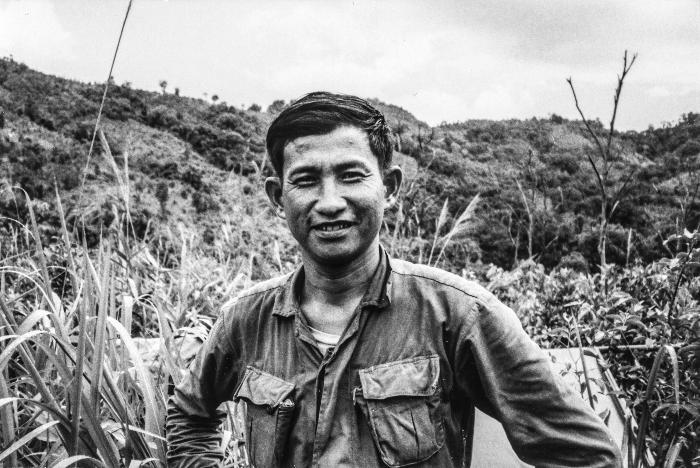
Lam, Vietnamese scout

Robert “Holly” Holloway in Base Camp
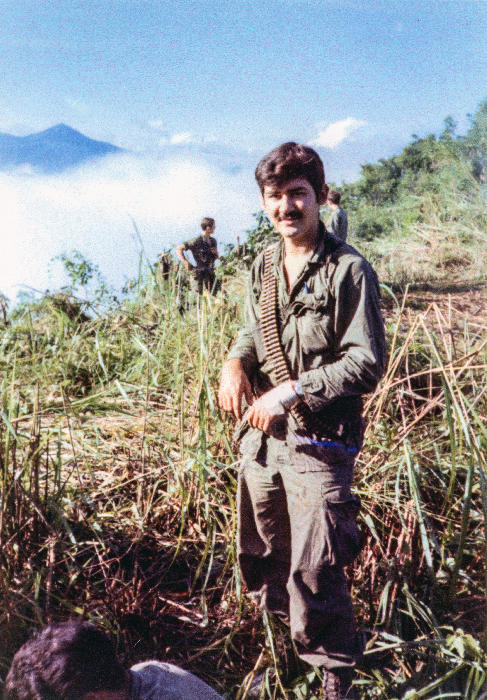
Jim Killian
Return fire is virtually immediate and voluminous, and up at the point unit we’re unsure of exactly what has transpired just ever so slightly behind us. Naturally, we immediately sought cover. The return fire quickly seems to aim in our direction. Thurman is slightly ahead of LT Warfield and myself and nearer the summit of the mountain, the LT begins to attempt to direct our return fire, but basically we are pinned down. As I’m closer to my point man, Jeff Thurman, than the LT is, I attempt to direct his fire. Jeff is pinned down in a small natural depression in the ground that allows him cover as if he’s in a dug out, one-man, prone fighting position but at the same time allowing him to focus his return fire on the enemy. The LT gets on the radio with SGT Buenzle, our acting Platoon Sergeant. Our platoon Radio Telephone Operators (RTO’s) that day were PFC Reynold Blazon and PFC David Brown, both experienced men with the PRC25 radio and both of whom performed their duties that entire day under extremely trying conditions.
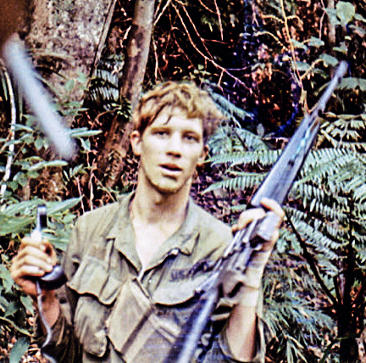 ----------
----------
Left: David Brown –
Right: Reynold Blazon
Platoon RTO’s
Photo of David Brown courtesy of David Brown
At one point, as the day and action wore on, PFC Brown gave control of his radio to Blazon and rejoined his old squad, Sgt Joseph “Cat” Akczinski’s squad, as a rifleman.
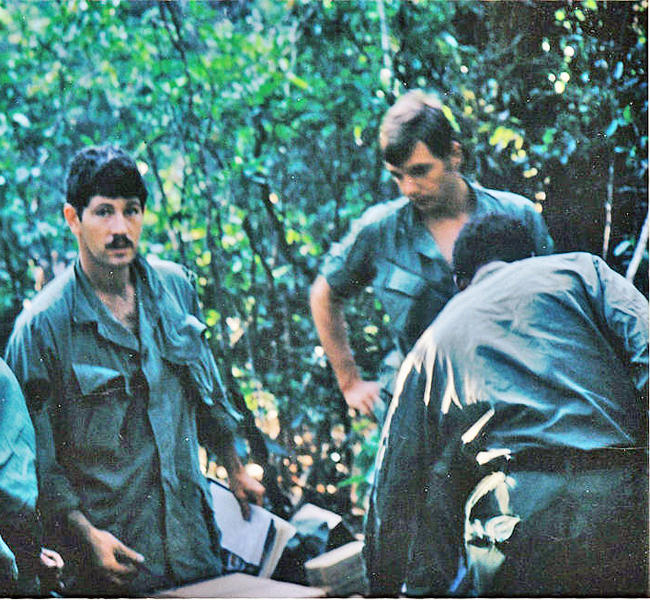
Left: SGT Richard Buenzle
Right: SGT Joseph “Cat” Akczinski
SGT Buenzle who is with the rear portion of the platoon, spread down along the trail, quickly agrees with LT Warfield to pull back slightly over the ridge line of the mountain to the right, or east side, of the mountain to what could be considered the eastern military crest and call in artillery. By 0953, we have called in an artillery fire mission. Charlie Battery 4/42 Artillery, stationed at Landing Zone (LZ) Niagara, begins to pound the Rock with 105mm High Explosive (HE) rounds.
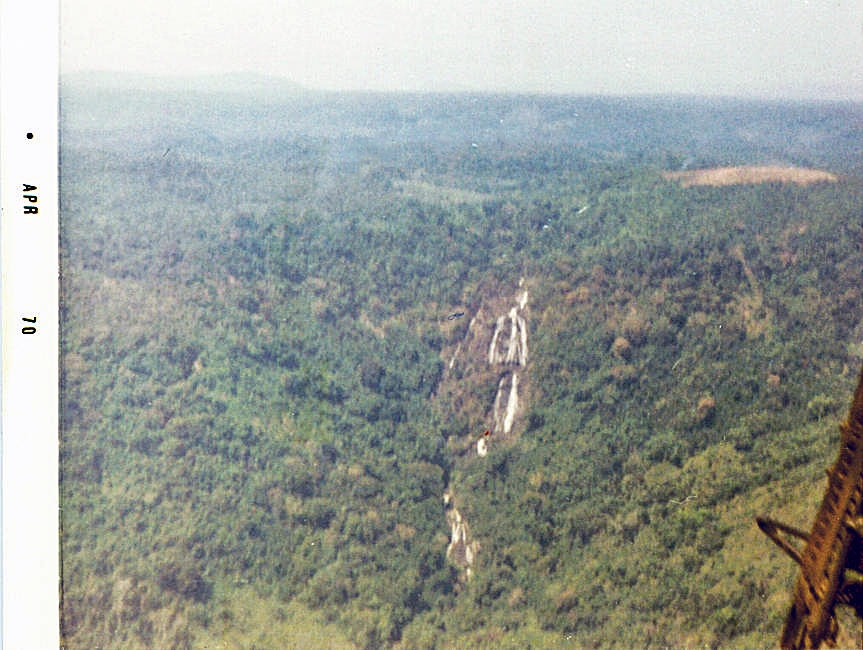
Waterfall below LZ Niagara. Firebase itself is in upper right of photo
Photo courtesy of Charles Chill

Charlie Battery, 4/42nd Artillery at LZ Niagara 1970
Photo courtesy of David Parrish
After the fire mission, we once again resume our previous positions on the trail and attempt to assault the Rock itself, although at this time we don’t even know that it’s a rock formation due to the incredibly thick, triple canopy jungle foliage and limited visibility. Again, we are met with fierce return small arms fire.

Thick, triple canopy jungle foliage
Photo courtesy of Jim Bacorn
At one point in time, I was
certain that they had a Light Machine Gun, (LMG), firing at those
of us up at the point location because the return fire was so
intense, but I’ve been overruled by everyone in authority,
so I’ll acquiesce that maybe they didn’t. But, if they
didn’t, they certainly fired at us with AK47’s on full
automatic. No one will ever convince me that they didn’t do
that, repeatedly. And the S-3 Logs clearly recorded that at some
point in time, someone claimed to have seen an M60 machine gun
caught in the rocks before we were forced to pull back, by the
time we finally returned, whatever it was, it was no longer
there.
On one occasion LT Warfield is attempting to give me fire
direction on where to direct my M79 fire, I am lying on my left
side propped on my left elbow, LT Warfield is lying on his right
side propped on his right elbow. We are facing each other maybe 2
feet apart. Suddenly about 6 or 8 rounds of fully automatic fire
rips between us, stitching a line right up the middle. It was
reminiscent of a scene from a movie and proof positive that God
wanted to spare us. We both, simultaneously, rolled away from one
another a full body roll and stopped in the same position we had
started in but now 6 feet apart instead of 2 and with eyes wide
as saucers. LT Warfield later said “…..for a time it
seemed the rounds were in slow motion as they hit one at a
time….” That is exactly as I remember it also. It is a
very odd thing how sometimes in times of such intense crisis,
time seems to slow into slow motion. Odd but true and heard
repeatedly from many people.
The LT also made the observation that “We were trying to hit
the limbs above the rock because the HE rounds wouldn’t
travel far enough in a straight line to arm themselves”. The
M79 High Explosive (HE) round was designed so that it had to
travel 15-25 meters before the round spun enough revolutions to
arm itself, thus preventing the user from being hit by his own
blast. The barrel was rifled with grooves and thus the round
began spinning as it left the weapon.
This should serve to help illustrate how close-in the fighting
was.
It was time for another regrouping and more shelling of the Rock.
Home | Photos | Battles & History | Current |
Rosters & Reports | Medal of Honor | Killed
in Action |
Personnel Locator | Commanders | Station
List | Campaigns |
Honors | Insignia & Memorabilia | 4-42
Artillery | Taps |
What's New | Editorial | Links |